Review: The Sculptor Behind The Mask – Mitzi Cunliffe’s work of the 1950’s @ Stanley and Audrey Burton Gallery
May 3, 2016
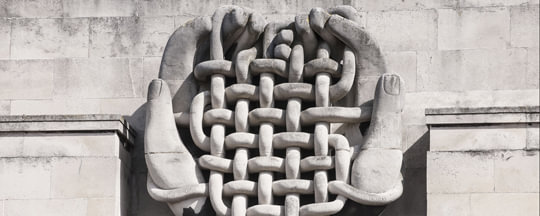
This year marks the 60th anniversary of the sculpture Man Made Fibers, which you can find positioned right on top of the Clothworkers’ South building at the University of Leeds. Until July, The Stanley and Audrey Burton Gallery is exhibiting the work of American sculptor Mitzi Cunliffe, in collaboration with her daughter Antonia, to help raise recognition of her magnificent art forms. The exhibition is titled ‘The Sculptor Behind The Mask’.
As I approached the exhibition, located in a quiet corner to the left of the gallery, I was met with a minimal, brightly lit space that presented the work of Cunliffe in a mainly monochrome fashion. I was drawn to the few subtle splashes of colour dotted around, and immediately approached what caught my attention first, The Coronation Fabric. Cunliffe created this piece in commemoration of Queen Elizabeth II’s Coronation, a relatively large rectangle of fabric, displaying many intricate squiggled lines that join up to illustrate a crowned lion and a unicorn. Initially, I was hit with a great sense of patriotism; the piece had a really British feel to it, despite its producer being native to New York. There were a few abstract additions of bright colour to the simple black and white piece, which really complimented the generally monochrome scheme of the exhibition. The Coronation Fabric shows Cunliffe’s experimentation with calligraphy, one of her many artistic talents amongst working with textiles, ceramics, jewellery and glass.
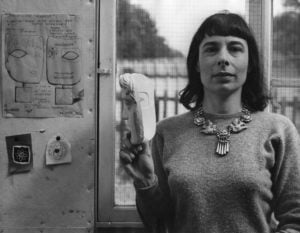
Mitzi Cunliffe with designs and a version of the BAFTA mask (credit: Estate of the artist).
Across the room I noticed a bronze maquette of the familiar sculpture, Man Made Fibers, that the artist created in celebration of the thriving textiles industry in Yorkshire during the 1950’s. The sculpture is made up of a pair of extraordinary hands, holding together a weave of threads, symbolizing the relationship between humanity and the production of synthetic fibers. It was said that Mitzi Cunliffe was an artist way ahead of her time, and to me this is reflected in the basic complexity of Man Made Fibers. Its simple yet tangled design oozes elements of modernism whist keeping a sophisticated aesthetic. There seems to be a running theme of hands in the sculptors work, as through the glass below me I am met with yet another pair of bronzed hands. Except this time, they are extremely elegant looking and relatively abstract in design; Henry Moore influences in Cunliffe’s work begin to shine through. This original piece titled ‘Push and Pull’ was produced as handles for the front doors of a restaurant. The prestigiously golden hands, which were to be contrasted with glass doors, also provoked a sense of modern, art-deco-type style.
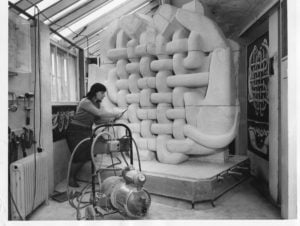
Mitzi Cunliffe working on Man-Made Fibres in her garage-cum-studio in Didsbury, Manchester, in the mid-1950s (credit: Estate of the artist).
The exhibition includes a vast range of photographs documenting Mitzi Cunliffe’s production of other works such as the screen for Red Roses Restaurant, which was displayed in the John Lewis department store of Liverpool. As well as her commission for Manchester School for Girls, titled Threshold. Also on display is a range of letters and press releases. We can see Cunliffe’s communications with Professor Speakman of Leeds University; some include inquiries about the arrival of the stone which the sculptor later created Man Made Fibers from, as well as advice on how to deal with the press of her commissions. The Stanley and Audrey Burton Gallery really give the viewer a chance to look in depth at the history of the artist’s work, showing her growth and development, but in addition to that, her downward spiral into worsening arthritis, which began to restrict Cunliffe’s impeccable ability for sculpturing. The gallery doesn’t hold back on the masses of background information, describing in detail when, where and how Cunliffe produced these incredible works that interweave sculpture with architecture.
Like a magpie to a shiny object, I gazed upon the piece that Mitzi Cunliffe is most famous for, the BAFTA trophy, originally named ‘the Jason mask’ by Cunliffe. This trophy in particular was awarded to David Lascelles for best drama series in 2011. The mask gleamed with bronzed authority and it was a pleasant surprise to see one of these in the flesh. A mirror is placed behind the mask to reveal the electronic symbol and the eye within a screen. Above this, I also notice an adorable miniature maquette of a small bird resting in the palm of yet another hand sculpture, the piece is called ‘Quickening’ and is made from light-coloured Spanish Marble. The maquette gave off a real sense of tranquility and peacefulness, corresponding to the gold, shiny trophy that stood beneath it, a major success symbol. The exhibition also displays a couple of examples of the artist’s ceramic pottery, which are beautifully curved in shape with stunningly neutral colour schemes. The pottery also added to the subtle dashes of colour, which I mentioned earlier, making for a visually stimulating exhibition.
The clean-cut, organized surroundings help keep all emphasis on the sensational works of Mitzi Cunliffe. The simple aesthetics in the layout adorn such works, which Cunliffe famously claimed she hoped to be ‘used, rained on, leaned against and taken for granted.’ The Sculptor Behind The Mask is an exceptional, and enlightening exploration into the life and times of this fine American sculptress, and will be running on until July 2nd at Stanley and Audrey Burton Gallery.
Filed under: Art & Photography
Tagged with: Jilly Forster, mitzi cunliffe, Stanley and Audrey Burton Gallery, The Sculptor Behind the Mask, University of Leeds
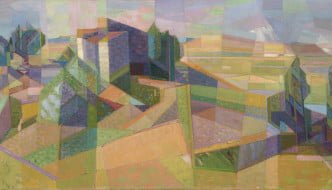
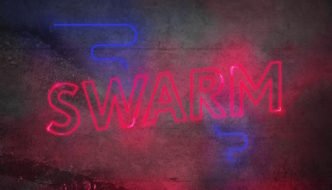
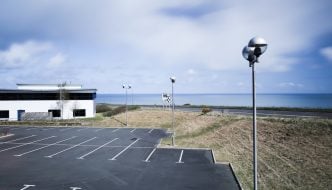
Comments